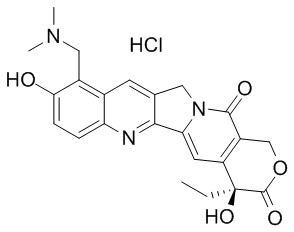Topotecan hydrochloride
Topotecan hydrochloride, a topoisomerase I inhibitor, capable of inhibiting tumoral growth in animal models of retinoblastoma. Topotecan hydrochloride liposomes loaded CS/β-GP hydrogel could become a potential formulation for improving the antitumor efficacy of Topotecan hydrochloride.
Inquire / Order:
manager@chemfaces.com
Technical Inquiries:
service@chemfaces.com
Tel:
+86-27-84237783
Fax:
+86-27-84254680
Address:
1 Building, No. 83, CheCheng Rd., Wuhan Economic and Technological Development Zone, Wuhan, Hubei 430056, PRC
Providing storage is as stated on the product vial and the vial is kept tightly sealed, the product can be stored for up to
24 months(2-8C).
Wherever possible, you should prepare and use solutions on the same day. However, if you need to make up stock solutions in advance, we recommend that you store the solution as aliquots in tightly sealed vials at -20C. Generally, these will be useable for up to two weeks. Before use, and prior to opening the vial we recommend that you allow your product to equilibrate to room temperature for at least 1 hour.
Need more advice on solubility, usage and handling? Please email to: service@chemfaces.com
The packaging of the product may have turned upside down during transportation, resulting in the natural compounds adhering to the neck or cap of the vial. take the vial out of its packaging and gently shake to let the compounds fall to the bottom of the vial. for liquid products, centrifuge at 200-500 RPM to gather the liquid at the bottom of the vial. try to avoid loss or contamination during handling.
Mol Biol Rep.2022, doi: 10.1007
iScience.2023, 26(9):107602.
Front Pharmacol.2018, 9:756
Sci Rep.2019, 9(1):4342
J Cachexia Sarcopenia Muscle.2022, 13(6):3149-3162.
Inflammation.2015, 38(4):1502-16
Antioxidants (Basel).2022, 11(12):2327.
Int J Mol Sci.2022, 23(11):6104.
Evid Based Complement Alternat Med.2020, 2020:9416962.
Sci Rep. 2024, 14(1):70.
Related and Featured Products
Histol Histopathol. 2012 Apr;27(4):497-506.
Topotecan hydrochloride effects on retinal vessels in newborn rats.[Pubmed:
22374727]
A physiological system, i.e. rodent retina during vessel formation and hierarchical organization, was utilised for assaying antiangiogenic properties of Topotecan, a topoisomerase I inhibitor, capable of inhibiting tumoral growth in animal models of retinoblastoma. In particular we analysed possible differences in effectiveness and side effects among different drug dosages and ways of administration.
METHODS AND RESULTS:
In the present research only qualitative analyses were undertaken. After preliminary experiments, in which suckling animals subcutaneously treated with Topotecan dosages comprised between 9 and 3 mg/kg underwent high lethality and extremely severe systemic damages, 7 day-old rats were subcutaneously, intravenously or peribulbary injected with a single dose of 1 mg/kg; retinal vessels were visualized in retinal fluorangio-graphies taken 1 and 2 weeks after treatment. The most important and frequent alterations were found to affect radial vessels, which showed non-perfused and/or regionally mislocated segments, together with abnormal branching and enlargements in retinal periphery; persistence of capillary-free periarteriolar regions, non-vascularised regions and spots of extravascular FITC were also detected. Despite the high individual variability the alterations were substantially similar among the different ways of drug administration, while they appeared milder in 21 day-old rats, with respect to younger ones.
CONCLUSIONS:
The extensive vascular remodelling found after Topotecan administration, besides demonstrating the antiangiogenic properties of this chemioterapic drug, confirms the rodent retina as a highly valuable model system for studying angiogenesis modulation.
Pharm Dev Technol. 2014 Jun 9:1-8.
Topotecan hydrochloride liposomes incorporated into thermosensitive hydrogel for sustained and efficient in situ therapy of H22 tumor in Kunming mice.[Pubmed:
24909735]
Topotecan hydrochloride (TPT) has potential for the treatment of ovarian cancer, but the activity of TPT tends to decrease due to the ring-opening at physiological pH.
METHODS AND RESULTS:
In this study, we proposed to incorporate TPT liposomes into injectable thermosensitive in situ hydrogel, consisting of chitosan (CS) and β-glycerophosphate (β-GP), for sustained release and preservation of active lactone form of TPT. The rheology studies were carried out to investigate the sol-gel temperature, flow behavior and viscosity of these CS/β-GP systems. The optimized formulation exhibited sol-gel transition at 40.2 ± 0.4 °C, with pseudoplastic flow behavior. The drug release rate of TPT liposomes loaded CS/β-GP hydrogel in phosphate buffer saline (pH = 7.4) was found to be slowed down, and the lactone fraction of TPT in the hydrogel matrix was maintaining 40% after 50 h. In addition, the antitumor efficacy in Kunming mice bearing Hepatoma-22 tumor, after intratumoral injection of TPT liposomes loaded CS/β-GP hydrogel, was higher than that of TPT in saline and TPT in CS/β-GP hydrogel.
CONCLUSIONS:
Those results demonstrated that TPT liposomes loaded CS/β-GP hydrogel could become a potential formulation for improving the antitumor efficacy of TPT and suggested an important technology platform for intratumoral administration of derivative of camptothecin-family drugs.



